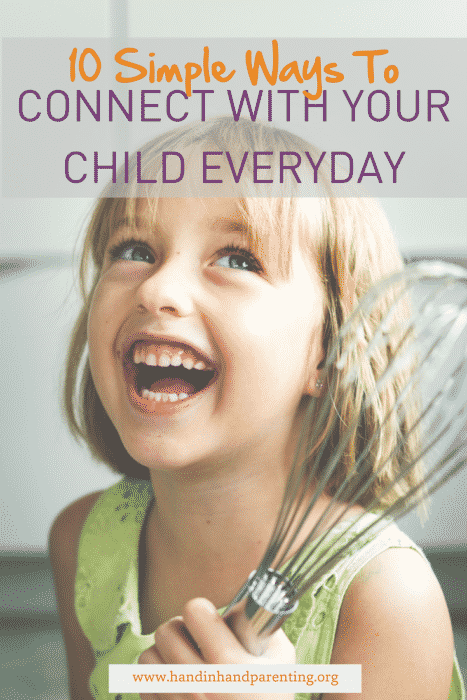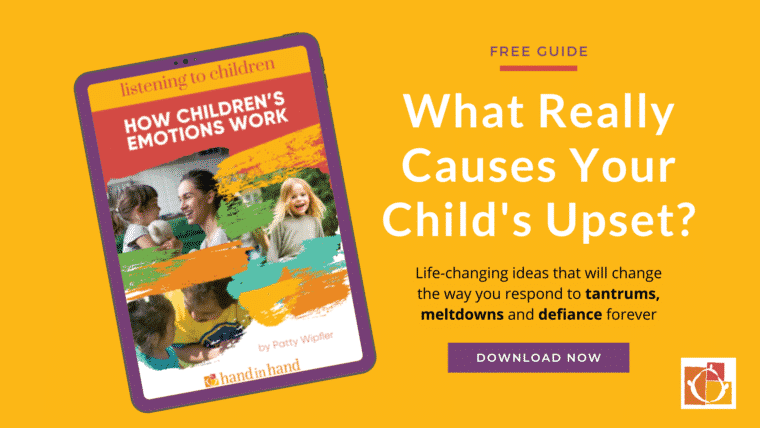 We all know that food and drink are essential for humans to survive. Connection is less thought about. But humans are wired for connection.
We all know that food and drink are essential for humans to survive. Connection is less thought about. But humans are wired for connection.
When your child comes off the slide with a bump, what is the first thing he does, even before he cries? He looks to his parent. He looks for his safe protector. That protective instinct is built into our systems though the part of the brain known as the limbic system. Minute by minute this system scans a child's environment, looking for safety. A loving parent or caregiver provides just that security he needs.
When a child feels secure, he feels content and confident and better able to follow your requests or attempt new things. And aside from the added cooperation, connection feels good for parents too. Creating connective moments with our children reminds us to slow down and enjoy them, to forget the emails or beds that have gone unmade, and to snuggle or laugh or really hold space for our little ones.
That said, the emails do have to get done, sometimes making the bed feels like top priority, so fitting in connection can feel like a tall order – unless you build it in, minutes here and minutes there, to your daily routine. Once established, you'll likely see your relationship transform positively. With more trust between both of you, more understanding, and more connection, you'll see greater cooperation and the need to guide and direct less.
Even better, these connections last infinitely, long after your child leaves home, when you'll be left with a heart full of bright shared moments.
Here are 10 Ways to Connect With Your Child Daily
Laugh Together and Often
Laughter shifts light tensions and works really well to clear out the storm clouds (for them and you). Get silly. Play bucking broncos or piggy back rides. Blow up a balloon or two and lob it across the living room. Younger kids delight in hide and seek where they can jump out of their hiding spot and surprise you. Go for giggles and belly laughs, and try not to overpower the kids. They'll reap the rewards of increased confidence and added connection when they can win.
Want to play but feel too exhausted? Try these games for Parents Too Tired To Play.
Snuggle Up
Who doesn't respond well to a good snuggle? Whether you have a school reading book to finish, or you are reviewing your day under the bed covers, get in a daily amount of snuggle time. You can even tell your child you need a good snuggle and give chase as they are running away squealing. That's laughter and closeness in one.
Look Kids in The Eye
He might be explaining to you the minute details of his latest Lego construction, or you may be telling her it's time to leave in five minutes, but getting down on their level and looking them deep in the eyes gives an immediate dose of connection that tells them ‘this moment is just for me.'
Make Small Moments Matter
How often do we find ourselves wishing time would just slow down? Spending quality one-on-one time daily with a child helps us savor the small moments and keep in tune with the person they are becoming. The best way is to invite them to do whatever they want for five or 10 minutes in your company. Let them direct the play while you follow and set a timer to make it official and ward off any distractions. In Special Time like this, you don't need to offer suggestions. If they want to build a tower that you know will fall, let them, and be there to help them re-build. Delight in those minutes as they work through their plan. Place blocks where they tell you. If it falls, just listen, or simply say, “Oh. It fell,” in a no-big-deal way. Shine your attention on them and delight in their problem-solving. They'll drink it in.
Respond Playfully
 Complaints and whining happen when a child is feeling listless and disconnected, but it isn't to annoy you, behaviors like these are a misguided aim to grab your attention. Responding playfully to minor upsets like these shows a child that you are listening and that a situation isn't as nearly bad as they might perceive. How does a playful response look? If a child is begging for more snacks, tell him that you are The Snack Monster. Scoop him up and nuzzle and play nibble him instead. If he is screeching, pretend to hide and say, “Now who let that stray old cat in? I'm petrified!” and run away and hide.
Complaints and whining happen when a child is feeling listless and disconnected, but it isn't to annoy you, behaviors like these are a misguided aim to grab your attention. Responding playfully to minor upsets like these shows a child that you are listening and that a situation isn't as nearly bad as they might perceive. How does a playful response look? If a child is begging for more snacks, tell him that you are The Snack Monster. Scoop him up and nuzzle and play nibble him instead. If he is screeching, pretend to hide and say, “Now who let that stray old cat in? I'm petrified!” and run away and hide.
Fight When They Want To
When your child challenges you, take it seriously – as a sign they need you close. If a child threatens to whack you with a cushion, he or she is actually saying, “Hey! Come play with me, let me show you how powerful I am.” Announce that they'll never get you, but accept that for five minutes you'll let them bound and chase and whack you with those cushions. And do let them catch you. When a child feels stormy, perhaps from that argument at school, or feeling left out at lunch, he or she carries those feelings around until smartly finding a way to clear them. One way to do that is through physical activity. Guess why he chooses you? There's trust in your company. You are a safe zone for the feelings that need to be expressed. Gently move back on track if the hitting or thwacking becomes aggressive, and try and ensure there is plenty of laughter. This is most often achieved when you “miss” the child you are playing with, letting them “get” you.
Listen Without Offering Advice
It's easy for parents to jump in when children come to you with issues. Whether it's a toddler telling you that “Jay Jay was mean,” or a pre-teen saying, “I hate math!” we jump in to advise. Naturally, we want to help, but a way to boost connection is simply to hear them out. They want to know that you're there and that you empathize, just like our best friends do for us when we have a bad day. This is not to say that you act like a friend instead of a parent, but there is plenty of time to have a conversation when the emotion around an issue dies down later – after your child has had a good rant about it and has off-loaded those feelings.
Be The Anchor
When your child is upset, be their anchor. Give them a warm loving spot to come and cry (even if they've told you to go away or leave them alone). Letting them cry is good for helping get their big emotions out of their systems, and teaches them that all feelings are OK by you.
Get Affectionate
Physical touch offers instant connection, so hugs and kisses when you wake up in the morning, or say goodbye for school work feel great. A touch on the shoulder while he is waiting for you to finish a conversation, asking them to sit next to you on the sofa and entangling legs while you relax feels warm and comforting. Sometimes, when a child is struggling, a hug while you listen works better than words. Some parents have better success getting though homework when their child completes an assignment sitting on their lap. Physical affection tells a kid he's secure even when words don't.
Switch Places
Parenting so often seems about guidance, teaching, and setting the pace, so take some time off that when you connect with your child and put him in charge. This role reversal can be a really powerful trust builder, and it can force you to go places you rather wouldn't. Ten minutes of playing shoot 'em up can be torture for some parents, while ten minutes dressing up dolls or Mindcrafting is worse for others. But try looking at it like this: You are seeing your child through his world. By following them in their likes, grown-ups see the world from their child's perspectives, being his most authentic self. And once kids are invested, issues that bother them often creep into play. If the Barbie dolls begin being catty, you might understand some more of your child's classroom dynamic, for instance. Meanwhile, your child will delight in showing you how to do things, rather than the other way round, and we've yet to meet one who doesn't delight in being the boss.
More from the Hand in Hand Toolbox
Read about five connection tools that will transform your parenting.
Join us in our online class of Taming Sibling Rivalry.
Get this free Guide to Special Time with Checklist.
The science behind your child's big feelings
Learn what science says about why kids rage, tantrum and meltdown – and how you can use connection to co-regulate and restore calm.
Get your guide here
